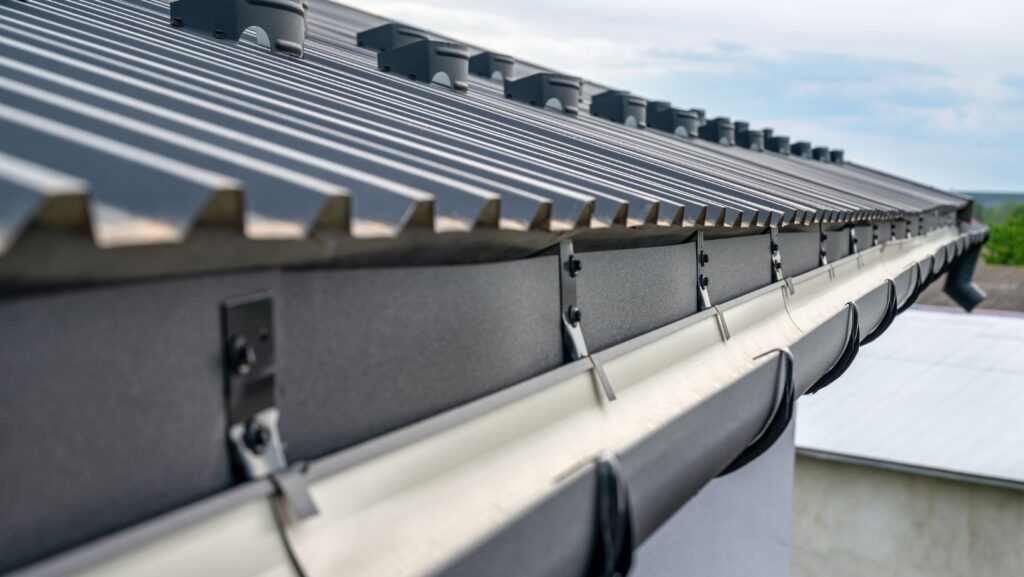Commercial roofs are more than just a covering for the top story; they are an integral part of the structure that shields everything below. But even the sturdiest roof can fail if water doesn’t have a clear path off it. That’s why proper roof drainage systems should be in place. These are important for building maintenance, shutting rainwater and melted snow away from your structure.
Why roof drainage matters
Think of your roof as a watershed. Every drop of rain that hits it needs somewhere to go. Without an effective drainage system, that water starts to pool. And standing water on a roof is bad news.
First, there’s the weight issue. Water is heavy – about 5 pounds per square foot for every inch of depth. A few inches across a large commercial roof can add tons of extra weight, stressing the structure.
Then there’s the wear and tear. Water that sits on your roof degrades materials faster. It can work its way into tiny cracks, expanding them as it freezes and thaws. This leads to leaks, which can damage inventory, equipment, and the building’s interior.
Poor drainage can also become a reason to mold growth, ice dams in colder climates, and even structural damage if left unchecked. In short, investing in proper roof drainage is investing in the longevity of your entire building.
Components of an effective roof drainage system
A well-designed roof drainage system has several key parts:
1. Slope: The roof itself should have a slight pitch to encourage water flow towards drains.
2. Gutters: These catch water at the roof’s edge and channel it towards downspouts.

3. Downspouts: Vertical pipes that carry water from the gutters to the ground.
4. Scuppers: Openings in parapet walls that allow water to drain off flat roofs.
5. Internal drains: On larger flat roofs, these funnel water directly into the building’s plumbing system.
6. Crickets: Raised areas that divert water around chimneys or other roof protrusions.
Designing for your climate
There is no right drainage system. Everything is based on the weather trends in your area. For example, rain may not fall frequently in Los Angeles, but when it does, it can fall heavily. Metal roofing contractors in Los Angeles often design systems to handle these sudden deluges. They might use larger gutters or more frequent downspouts to clear water during rare but heavy rainstorms quickly.
In contrast, areas with steady rainfall might focus more on corrosion-resistant materials and ease of maintenance. Snowy regions need to account for the weight of ice and snow, as well as the water from melting.
Common drainage problems and solutions
Even well-designed systems can run into issues. Let’s discuss some common problems and their solutions.
Clogged gutters: Regular cleaning is essential. Consider gutter guards to reduce debris buildup.
Inadequate slope: If water pools on your roof, it may need re-pitching. This is a job for professionals.
Undersized components: If your system can’t handle the water volume, you may need to upgrade to larger gutters or add more downspouts.
Ice dams: In cold climates, proper insulation and ventilation can prevent these dangerous ice buildups.
Deteriorating materials: Over time, gutters and downspouts may rust or crack. Regular inspections can catch these issues early.
Why do regular maintenance?
Like any building system, roof drainage needs ongoing care. A good maintenance program includes:
- Regular inspections (at least twice a year)
- Clearing gutters and downspouts of debris
- Checking for and repairing leaks
- Ensuring that water is directed away from the foundation by downspouts
- Inspecting the roof surface for ponding or damage
Many building owners find it worthwhile to contract with roofing professionals for this maintenance. They possess the knowledge to identify possible problems before they turn into significant ones.
Upgrading your drainage system
If your current system isn’t cutting it, it might be time for an upgrade. Modern materials and designs can drastically improve drainage efficiency.

When considering upgrades, it’s worth consulting with experienced professionals. They can recommend solutions to your building’s specific needs and local climate conditions.
Conclusion
Proper roof drainage might not be the most exciting aspect of building management, but it’s undeniably one of the most important. It protects your investment, ensures the safety and comfort of occupants, and can even contribute to your bottom line through energy savings and lower maintenance costs.
For commercial building owners and managers, regular inspections and maintenance of your roof drainage system should be a top priority. And when it’s time for upgrades or repairs, don’t hesitate to call in the experts.



